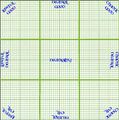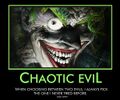Alignment

Alignment is a way of quantifying ethics/morality in Dungeons and Dragons. People, creatures, spells, objects, and places can have an alignment. The term is used in other role-playing games whenever characters or NPCs have a simple stat for their own code of conduct.
Alignment has spawned more debates and motivational posters than anything else in D&D. Alignment threads now belong in /co/ after we swapped them for Empowered. Post alignment threads at risk of sagebombing.
Some argue that taking alignment seriously in any way entails failure because it tries to simplify and categorise something philosophers, sociologists, theologists and psychologists have been debating for thousands of years with no tangible results. A famous example shows the goddamn Batman in various periods of his comic and his actions and words correspond to pretty much all existing alignments. Recent developments in D&D (Eberron, 4th Edition) have been relaxing and ignoring the old rigid structure.
Others argue that those people don't understand fuck about how the two-axis alignment system is meant to work and that using an inconsistent comic book character who has been written by dozens of different people over the course of his existence to try and demonstrate that the system fails is completely missing the point.
Debate continues.
Alignment in different editions
- Original D&D had just three categories: Lawful, Chaotic, and Neutral, which corresponded to "good guy," "thieving scum," and "regular person." Probably got the idea from Michael Moorcock novels.
- Advanced D&D (aka 1st edition) replaced the three alignments with Good, Evil and Neutral, and then added another axis for Lawful, Chaotic and Neutral. It was laid out in the back of the Player's Handbook in an appendix with the diagram at the top of this page. The Good/Evil axis was pretty much "Hero/Villian", Lawful meant law-abiding and Chaotic meant rebel. You could have mixes of the two axes, like Lawful-Neutral or Chaotic-Good to get more variety. Your alignment also determined what sort of an afterlife awaited you, and the diagram of the "Outer Planes" (also in an appendix) corresponding to the character's alignment.
- AD&D 2nd Edition, and 3rd (and 3.5) Editions made no changes to alignment. Same two-axis method, same class restrictions, same hating people who were on the other side of the chart from you.
- 4th Edition made a controversial change. Instead of the classic 3x3 grid which has served us well since the 1970's, the alignment system was changed to a single axis with four positions: good, lawful good, evil, and chaotic evil, with the added option of being unaligned (free to do whatever - not to be confused with the old Neutral). The point being that alignments should be a conscious effort on the part of the player, rather than acting as a personality anchor. As with many of the changes implemented in 4E, this has caused much heated, vigorous discussion about the subject.
The Alignments (And Why You Should Party Kill Them)
Lawful Good
Truth, justice, apple pie, and curbstomping. Their ridiculously rigid codes of morality will often lead them to betray the party when you kick a bunny or try to use some cool demonic swag. When they start to complain about the party's "evildoing" have the rogue engineer an "accident" for them.
Beware of Lawful Stupid.
Neutral Good
The quintessential "nice guy". Is overridingly concerned with being "good", which is extremely vague but generally boils down to mincing around like a useless pansy and trying to talk their way out of every situation. His idiotic insistence on nonviolence is going to TPK the party when he tries to negotiate with Orcus. Tell him to go make friends with a wolverine and head back to the inn for a drink.
Chaotic Good
A chaotic good character is someone who means well. They mean well, but unfortunately, in their attempts to mean well, they may break a few laws (or steal from a bank or kill a guy). And sure, that cop beat his wife or took drug money... and maybe that bank was run by the mafia. But the fact remains he broke rules, he broke them for good reasons, but he broke them. His well intentioned extremism is going to get you in deep shit with the man, so be sure to betray him to the establishment at first opportunity.
Lawful Neutral
Think Paladins without the morality. So basically superhuman DMV employees. At best they're obstructive bureaucrats, at worst they're insufferable Rules Lawyers given the license of roleplay. They're going to turn on you the second you jaywalk across the street to stop a mugger, so as soon as you get out of town leave them in a shallow grave.
True Neutral
Comes in two varieties: "dedicated to balance" True Neutral and "can't be bothered to care" True Neutral. "Don't care" types are either extremely uninspired roleplayers, NPC villagers, or bears. "Balance" type roleplayers tend to be some of the more insufferable types since they think they're balancing some cosmic chequebook, and their actions are almost always indistinguishable from chaotic neutral to the casual observer. Better kill this guy too before he decides to even out the ledger by murdering the cleric.
Chaotic Neutral
The original interpretation was the agent of chaos. Characters of this alignment were often random and completely inconsistant as long as chaos was achieved. Anarchistic and individualistic, AD&D 2e notes that they are extremely difficult to deal with due to their unreliable nature. Abandoned 3.X onwards when everyone realized no-one could ever play this alignment longer than 5 minutes before suffering a forced change for the sake of adventure. That is, of course, if the character wasn't killed thanks to AD&D's high character mortality rate. The current interpretation of this is a perfectly amoral and self serving character. One who isn't necessarily evil but believes in maintaining their own self interest (or cause) above all others. The player interpretation of this is "what ever the fuck I want, whenever the fuck I want". Usually used directly after the DM bans evil alignments and directly before the DM ragequits. Best chance to save the group is to ice the jerk before Rocks fall, everyone dies.
Lawful Evil
Your fascists, social Darwinists, contract killers, and anybody else who can be reliably and systematically counted on to be a dick. The endgame is almost always multidimensional domination, so be sure to kill them before they get too poweful.
Neutral Evil
The asshole alignment. Follows the law as long as it helps them, then breaks it. Ingratiates themselves to people, before betraying them. Does good deeds, until they cease to elevate them. If he's being an insufferable prick you should probably just kill him, nobody will question you. If he's generally acting like a good guy you should definitely just kill him, he's up to something.
Chaotic Evil
Kill him the second he turns away and leave him in a ditch, before he gets the chance to do the same.
Alignments in other RPGs
- White Wolf's World of Darkness games use a shopping list of Jungian archetypes to describe a character's personal code of conduct, described as their "Nature." The games have much emphasis on social interactions, betrayal, deception and general being a bastard, so there's also the archetype they present publically, called their "Demeanor." Good or evil can be a bit irrelevant when the player characters are all vampires/ werewolves/ demigods/ dead/ half-imaginary. Characters that behaved appropriately to their Nature archetype were gained a stronger self-confidence, evidenced by awarding "willpower" points they could spend later to make tasks more likely to succeed.
- d20 Modern uses "allegiances" instead of ethics, indicating the character subscribes to an established code of conduct, or the mores of a social group. Dealing with an NPC with a matching allegiance gives the player a +2 circumstance bonus to social tasks. If an NPC witnesses you violating one of their allegiances, that's a -2 for any social tasks with that NPC evermore. Characters can have multiple allegiances, each providing the +2/-2 when appropriate, but not cumulatively.
- Palladium Fantasy RPG (and all Palladium games that came later) used three categories for alignment: Good, Selfish and Evil. These broke down into seven alignments: Principled, Scrupulous, Unprincipled, Anarchist, Aberrant, Miscreant, and Diabolic. They added "Taoist" for their Kung-fu games, but nobody used it.
- GURPS didn't have alignments. Instead, it was a long list of mental disadvantages you could take during character generation to restrict the character's behaviour. Since characters were on a point-buy system, these disadvantages could be traded for other advantages. You could take Compulsive Honesty (-10 point flaw), for enough points to get you Ambidexterity (+10 point advantage), or Kleptomania (-15) for a military rank of Lieutenant (three ranks @ +5).
- Warhammer Fantasy had five alignments on a linear scale: Law - Good - Neutral - Evil - Chaotic. This was used as a rule of thumb for reactions between people -- identical alignments would be well-disposed towards each other, but the further apart alignments are, the more likely things will come to blows. A character's alignment could shift at most one step left or right from where they started. Later editions of Warhammer de-emphasizes the alignment system in favour of allegiances and broad personalities.
Gallery
Did we mention that alignment charts are a meme?
-
An alignment chart for gradient alignment tracking.
-
Optimus Prime; whitest trucker's cap anywhere.
-
Batman is a complex guy
-
Governments should be afraid of their people.
-
"When chosing between two evils, I always pick the one I haven't tried before."
-
The fate of the universe is too important to leave to some goody two-shoes.





